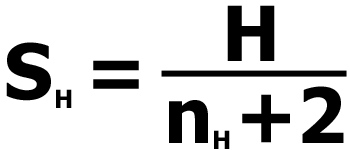Tension (SH and SW)
In this section we are going to use a tension patch to work out average Stitch Height (SH) and Stitch Width (SW), the basic units of mathematical design.
Introduction
A tension patch is used to check that when you knit something (most likely clothing) the result is the same size as the pattern intended. ODDknit patterns rarely require you to knit a tension patch because they are designed to be small and fun, not usually wearable.
However when you design with maths you will need to knit a tension patch. You use it to work out the average width (SW) and height (SH) of a stitch. The process of mathematical design depends on being able to predict how many stitches you will need for a given shape – and how many stitches you will need depends on what size they are.
Knitting your Tension Patch
Factors that influence the size of a stitch are the type of yarn, the size of needles, the knitting stitch and the tension with which you hold the yarn. Try to make all these the same in the tension patch as they will be in the final object.
To knit the tension patch cast on at least 20 stitches, work around 30 rows and then cast off.
You can cast on any number of stitches you like, or work any number or rows, the important thing is that you keep a record of the numbers for the next step. See increasing accuracy for tips on how to get more precise results.
Stitch Width (SW)
Measure the width (W) of the tension patch.

Divide the width of the patch by the number of stiches that were cast-on (nW). This gives us the individual stitch width. As an equation this is written:

Stitch Height (SH)
Measure the height (H) of the tension patch from the cast-on edge to the cast-off edge.

Divide the height of the patch by the number of rows (nH) with two added (we are averaging the cast on and cast off edge into the stitch height by counting them as complete rows). This gives us the stitch height. As an equation this is written:

Example 1
Find SH and SW for garter stitch done with double knit yarn on 3mm needles.

Cast on 20 stitches with given yarn and needles. Work 30 rows, and cast off.
The width of the resulting tension patch was measured as 73mm. 20 stitches were cast on.
SW = 73mm ÷ 20 = 3.7mm
The height of the patch was measured as 57mm. 30 rows were worked in addition to the cast on and cast off row.
SH = 57mm ÷ 32 = 1.8mm
Example 2
Find SH and SW for lattice stitch done with double knit yarn on 4mm needles.

According to the instructions this type of Lattice stitch is worked in multiples of 6 + 1. The extra "+1" stitch is added on to each line to make the pattern symmetrical. It would be more accurate to leave the extra stitch out of our tension patch, but then again it would be more work to re-write the pattern. Any difference made to SW will be tiny so the extra stitch is staying in.
Cast on 19 stitches with given yarn and needles. Work 18 rows (3 repeats) of the following pattern, and cast off.
- Row 1: k1, [k2, p1, k3] x 3
- Row 2: p1, [p1, k1, p1, k1, p2] x 3
- Row 3: k1, [p1, k3, p1, k1] x 3
- Row 4: k1, [p5, k1] x 3
- Row 5: as row 3
- Row 6: as row 2
The width of the resulting tension patch was measured as 86mm. 19 stitches were cast on.
SW = 86mm ÷ 19 = 4.5mm
The height of the patch was measured as 55mm. 18 rows were worked in addition to the cast on and cast off row.
SH = 55mm ÷ 20 = 2.7mm
<<< Back to Tension.
© 2010-2016 All desgins and images are copyright of ODDknit.


